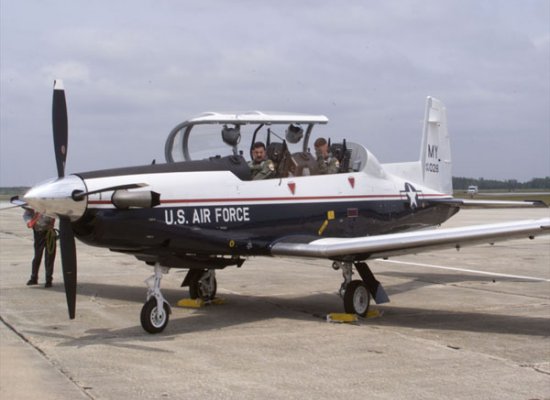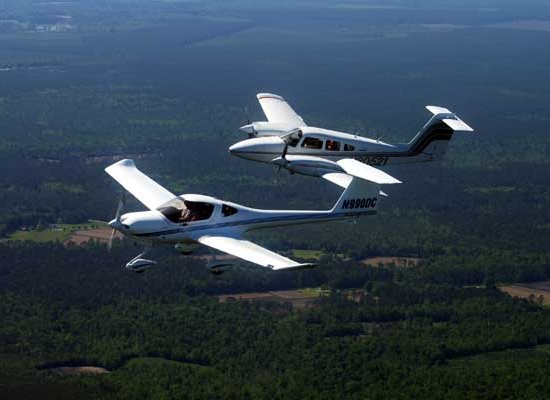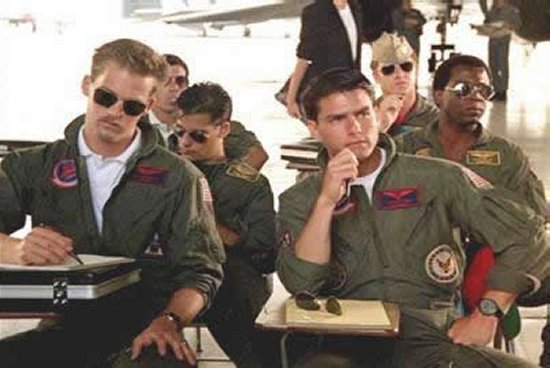|
||||||||||
|
|
||||||||||
|
||||||||||
|
|
||||||||||
Though it may seem contradictory, at least half of commercial pilots traditionally come through the military. Upon joining the military, a person hoping to become a pilot must first be accepted into officer training. Successful completion of this program, passing tests, and meeting physical qualifications may allow a candidate to be selected for pilot training. This period usually takes one to two years during which the candidate takes several classes in addition to basic and advanced flight training. Upon graduating from training, the candidate earns his or her pilot wings and goes on to additional training on a specific aircraft type. This period usually takes several more months, and the pilot must also pass survival training before becoming a fully active military pilot.

Completion of this lengthy and expensive training requires the pilot to commit to remaining in the military for several years. A pilot trained by the US Air Force, for example, must remain in the service for at least ten years. The advantage of this career path is the training is paid for by the military and retired military pilots are highly skilled and experienced individuals sought after by airlines. Upon retirement from the US military, an individual who wishes to become a commercial pilot must apply for a commercial license from the Federal Aviation Administration (FAA). If the pilot has flown within the past year, the candidate can take his or her flight records to one of the FAA's Flight Standards District Offices and be issued a civilian license. If the pilot has not flown during the past year, he or she must pass flight tests administered by an FAA representative.
A civilian pilot pursues comparable education and flying experience through colleges or flight schools. Two- and four-year colleges often offer degrees in aviation that include flight training towards various levels of flight certificates. A successful student can complete an associates or bachelors degree as well as earn a commercial pilot license with multi-engine and instrument ratings at such schools. Another option is technical schools that offer flight training towards a certificate and generally take less time than a college degree. Yet another path for pursuing a commercial license is through small flight schools. This type of training may take longer than a college program but usually offers greater flexibility to part-time students.
The advantage of the civilian approach is a graduate is free to pursue a commercial career more quickly than someone in the military. The disadvantage is cost since a military pilot's training is paid for by the service but a civilian pilot must obtain college scholarships, take out student loans, or pay the training expenses out of pocket. Attending school and earning all the ratings required for an airline pilot takes years and may require some $20,000 or more. A breakdown of the cost required for each step to become an airline pilot is further described in the following sections.
Each of these licenses and ratings typically requires passing three tests. First is a written exam with a passing grade of 80% or higher. Next comes an oral exam that typically lasts between one and two hours. The final step is a flight test, usually with an examiner from a licensing-body like the FAA along for the ride.
Private Pilot's License
A pilot hopeful must first earn a private license either by taking flight classes at a local airport or attending college. This introductory level includes several classes about aerodynamics, flight characteristics, and operation of a plane. Other training includes courses in airport operations, communications with other aircraft and air traffic controllers, navigation skills, flight planning, weather, and aviation regulations. The student also takes flying lessons of increasing complexity with an instructor pilot culminating in the ability to fly solo. In order to earn the license, the student must pass a written exam, an oral exam, and a flight test. Successfully earning the license allows the holder to rent or buy an aircraft and fly solo or with others under visual flight rules in good weather. Basic flight training starts at about $80 per hour and the total cost to earn a private pilot's license is typically around $6,000.

Commercial Pilot's License
A commercial license is required for any pilot who wishes to hire out his or her flying abilities. Earning the license requires completing at least 250 flight hours including time flying under certain conditions and performing certain kinds of maneuvers. The license in and of itself does not require much additional training but the pilot must demonstrate increasing levels of skill and experience to show he or she is competent enough to be employed. The pilot must demonstrate the ability to operate a plane equipped with flaps, retractable landing gear, and a propeller controlled separately from the engine throttle alone. After earning the required flight hours and completing a written ground test, the pilot's skills in these areas are further tested in flight during a check-ride. This test is administered by an FAA examiner who has the pilot plan a flight, gives an oral examination on various aviation topics, and then accompanies the pilot during a flight. The examiner directs the entire flight and requests the pilot demonstrate the ability to perform certain maneuvers along the way. If the pilot is successful, the examiner will issue a commercial pilot's license after landing.
The commercial license can be used immediately for a pilot who wishes to fly single-engine tourist sight-seeing planes, tow gliders or aerial banners, or conduct other types of local flying in good weather. Additional types of commercial flights, including becoming an airline pilot, require advanced ratings and licenses to operate more complex types of aircraft in all weather conditions.
Medical Certificate
Before allowed to fly solo in any powered aircraft, a pilot must obtain a medical certificate from an aviation medical examiner authorized by the FAA. This documentation certifies the pilot meets the health and fitness requirements of a pilot and must be renewed periodically. The certificate comes in three types. A first-class certificate is required for an airline pilot, second-class is needed by commercial pilots, and third-class covers students or private pilots.
Instrument Rating
An instrument rating allows flying in low-visibility conditions when the pilot has no ground reference. Such conditions include flying at night, in bad weather, in or above clouds, and through any other visual obstruction. The rating is obtained by attending instrument ground school where the pilot learns to operate the plane purely using instruments and displays in the cockpit and navigate only by electronic guidance. The pilot must also fly a certain number of hours using instruments, pass written and oral exams, and pass an instrument check-ride with an FAA examiner. Both private and commercial pilots can pursue an instrument rating, and most professional pilots train for the commercial license and instrument rating at the same time for a total cost around $7,500.

Multi-Engine Rating
An airline pilot also requires a rating to operate aircraft with more than one engine, like commercial jets. The main purpose of training is to teach the pilot what to do during an engine failure. This failure creates unbalanced forces on the plane and the pilot must know how to react to maintain control. Multi-engine planes also tend to be larger and more complex machines with many additional systems compared to single-engine aircraft. Pilots are trained to operate these new systems in the faster-paced environment common of larger, high-speed planes. The pilot must pass another FAA-administered oral exam and flight test, though this step is the only license or rating without a written exam. Completing the rating costs about $4,000.
Flight Instructor's License
This license is not necessarily required to become an airline pilot but is an excellent way of building up the experience needed for an airline job. At this step, a pilot must demonstrate sufficient skill to be capable of teaching another pilot. The candidate is required to fly the maneuvers of a commercial pilot license from the right, or co-pilot seat, since a student would occupy the left pilot seat. The instructor's license requires passing written, oral, and flight tests and costs about $2,500 to obtain. Once completed, an instructor pilot should be able to find a position in a flight school and build up flight time. A pilot will typically have about 250 hours after earning the license but will need at least 1,500 before being considered for a job flying large planes.
Instrument Instructor License
Complementing the flight instructor's license is the instrument instructor license that allows a pilot to teach others when they are working on their instrument rating. Again, the primary advantage of the license is the ability to get better jobs and build up more flight hours. As a pilot gains more experience, he or she can start looking for positions flying regional aircraft like commuter turboprops or small cargo transports.
Airline Transport Pilot License
The final license required for an airline pilot is the transport license that allows a pilot to serve as pilot in command aboard a large aircraft. The license requires passing written and oral exams, possessing a first-class medical certificate, at least a high school diploma, and having logged 1,500 flight hours including 250 hours as the pilot in command.

Even after all the time, cost, and effort to earn the above licenses and ratings, a pilot is only qualified to be hired at an entry-level position. Major airlines almost never hire someone who has just obtained an airline transport license but instead look for pilots with extensive flight experience. This experience includes not only thousands of flight hours but also the complexity and types of aircraft flown, the difficulty of flying done including long-distances or instrumented flight, and the crew positions held such as pilot or co-pilot. A pilot who has just received an airline transport license must work his or her way up the ladder through cargo shippers, flight training schools, business jet operators, charter services, regional commuter airlines, etc. to build sufficient experience.
A pilot must also continue training even beyond the licenses and ratings described above, especially to operate whatever specific airplane model the individual was hired to fly. Whenever the pilot moves to a different employer with a different fleet or wishes to upgrade to a new type of aircraft, additional training on that type is also required. Each airliner is different, so the pilot must receive type training to learn the specific details on how that particular model is operated. Even if flying the same aircraft model for a different airline, the pilot will be required to undergo that company’s FAA-approved training to ensure the crew follows the same standardized methods and cockpit behavior to avoid confusion. This intimate knowledge of the workings of each aircraft type and crew coordination is most important during emergencies when pilots often have very little time to make critical life-or-death decisions.
The initial training course taught by an airline lasts about ten weeks. The first couple of weeks cover basic indoctrination, regulations, and procedures specific to that airline. The remainder of the training is devoted to learning the details about the aircraft model the pilot is being specialized to fly and practicing in a simulator before taking the first familiarization flights. Some of the forms of training employers offer to their pilots are further described below.
Ground School
A recently hired pilot or one transferring from another type of plane first spends two or three weeks in classes learning the details about each system aboard a specific aircraft model. The pilots must understand how to operate electrical, mechanical, and hydraulic systems as well as how to read and interpret the temperatures, voltages, pressures, and other parameters reported on cockpit displays. The students may be frequently tested on their new knowledge through both written and oral exams.
Cockpit Procedures Training
Pilots next spend several days in a cockpit simulator designed to train the student on the location of each switch, gauge, button, light, or other instrument present on the real aircraft. Though none of these items actually work, the pilot must be able to locate and identify each of them by touch, since lighting could be lost in an emergency situation. The student also learns how each switch, knob, or button operates and whether it is pulled, turned, depressed, pushed, or some combination thereof.
Flight Simulator
During the next stage of training, two students are paired together to conduct two or more weeks of training in a fully functional flight simulator. This device is a full-motion room placed atop hydraulic jacks allowing it to move and rotate like a plane in flight. The interior replicates an actual aircraft cockpit including computer-generated views out the windows. Here, the pilots learn how to operate the plane in a realistic environment under the direction of an instructor. The students conduct simulated flights, takeoffs, and landings as well as stressful maneuvers at the limits of what the real plane can handle. Pilots are also subjected to a variety of emergency situations to evaluate how well they react and follow standard procedures.

Check-Ride
The final phase of simulator training is conducted with an examiner from the airline and possibly one from the FAA as well. The pilot must pass an oral exam and is then required to fly the simulator as directed while the examiners are present. This simulated flight test is referred to as a check-ride.
Line Check
After demonstrating sufficient proficiency in the simulator, the pilot must next prove his or her skills in the air. A special instructor pilot accompanies the trainee during 25 hours of initial operating experience. This period gives the new pilot the opportunity to try out the flight skills learned and practiced in the simulator during on-the-job training. The instructor, called the check airman captain, is often one of the airline's most senior pilots whose job is to verify that new pilots are qualified for their job.
Capping off this initial period is a final flight test called the line check. If successful, the check captain certifies that a new pilot is ready to be scheduled for regular flight duty. Airlines are also required to provide 100 hours of flight time after the line check to give the new pilot a chance to gain experience. If the pilot trainee fails any test during the period of airline training, additional work is required to demonstrate competence. After two failures, the employee could be fired.
Proficiency
Even after this long period of intense training, pilots must return to the simulator regularly to remain proficient in their skills. Pilots, also called captains, must complete proficiency training every six months while co-pilots do so once a year. The simulator testing is preceded by brief ground school training to refresh the crewmembers on aircraft systems and provide training in cockpit teamwork. If a captain or co-pilot ever fails a simulator test or a medical exam, they can be summarily fired. However, most airlines offer another chance to pass.
Clearly, becoming an airline pilot is a challenging proposition that requires a large commitment both in time and
money to achieve. Nevertheless, most pilots find it to be an exciting and rewarding career offering good salaries
and excellent opportunities.
- answer by Joe Yoon, 27 May 2007
Read More Articles:


|
Aircraft | Design | Ask Us | Shop | Search |

|
|
| About Us | Contact Us | Copyright © 1997- | |||
|
|
|||